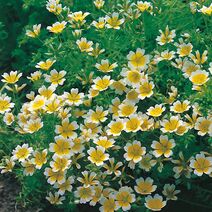Limnanthes douglasii
| Limnanthes douglasii | |
 | |
| Light: | |
| Moisture: | |
| Hardiness: | 5 |
| Soil pH: | 5.6-8.4 |
| Height: | 1' |
| Width: | 0.5' |
| Blooms: | Late Spring-Late Summer |
| Native to: | |
| Shelter Nectary | |
| Tea: | Yes |
Limnanthes douglasii (common names: poached egg plant and douglas meadowfoam)
Propagation: Seed - sow spring or autumn in situ[1]. Germination takes place within 3 weeks.
Cultivation: Succeeds in any soil, including sandy soils[2]. Prefers a fertile well-drained soil[3]. Prefers an open sunny position and a cool root run, doing well by concrete paths, rocks etc[2][4].
The flowers diffuse a gentle sweet perfume that is most pronounced on a calm warm day[5].
A very good bee and hoverfly plant[6][7][8].
Plants usually self-sow freely[3].
Range: South-western N. America - California.
Habitat: Moist places below 1000 metres[9].
Pollinators: Bees
Soil: Can grow in light, medium, and heavy soils.
Drainage: Prefers well drained soil.
Seed Ripens: Mid Summer-Late Summer
Flower Type: Hermaphrodite
Also Known As: L. sulphurea.
Links
References
- ↑ Rice, Graham. Growing from Seed Volume 2. Thompson and Morgan, 1988.
- ↑ 2.0 2.1 International Bee Research Association. Garden Plants Valuable to Bees. International Bee Research Association, 1981.
- ↑ 3.0 3.1 Brickell, Christopher. The RHS Gardener's Encyclopedia of Plants and Flowers. Dorling Kindersley Publishers, 1990.
- ↑ Huxley, Anthony. The New Royal Horticultural Society Dictionary of Gardening. MacMillan Press, 1992.
- ↑ Genders, Roy. Scented Flora of the World. Robert Hale, 1994.
- ↑ Chittendon, Fred. RHS Dictionary of Plants. Oxford University Press, 1951.
- ↑ Baines, Chris. Making a Wildlife Garden.
- ↑ Bird, Alfred. Growing from Seed Volume 4. Thompson and Morgan, 1990.
- ↑ Munz, David. A California Flora. University of California Press, 1959.